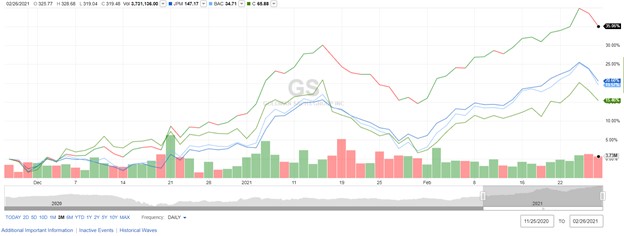The prospect of rising interest rates has propelled bank stocks to all-high highs. Citigroup (C), JPMorgan (JPM), Bank of America (BAC), and Goldman Sachs (GS) have appreciated double digits over the past three months, breaking out to all-time highs. Rising interest rates combined with the highly disruptive COVID-19 backdrop abating has served as the foundation for this move higher. The big banks responded and evolved in the face of COVID-19 to the real possibility of widespread loan defaults, liquidity issues, ballooning credit card debt, and stressed mortgages. To exacerbate these COVID-19 impacts, interest rates, Federal Reserve actions, yield curve inversion, and liquidity heavily weighed on the sector.
Along with this turn higher, balance sheets have become even stronger now that share buybacks have been halted and dividend payouts were arrested. Large capital reserves have already been put aside for anticipated financial challenges. The big banks have demonstrated their ability to evolve in the face of COVID-19 and present compelling value. Now with the prospect of rising rates, this may serve as a long-term tailwind for banks to appreciate higher.
COVID-19 and Financial Crisis – Lessons Learned
The big banks are far stronger and more prepared than they were during the 2008 Financial Crisis. Lessons learned from the Financial Crisis yielded rigorous annual stress tests that forced banks to maintain a slew of fiscal discipline measures. With the Federal Reserve working in-hand with the banks, a financial bridge to those businesses and consumers negatively impacted by COVID-19 as a stop-gap measure has been afforded. As this pandemic subsides and economic activity rebounds the banks' present value. Add in the prospect of higher rates, and the banks are set-up for long-term appreciation. Their strong cash positions and healthy balance sheets are allowing dividends to continue as the economy transitions through the damage of the pandemic.
These Stocks Are Ready to Break Out
Over 5K stocks are trading on the U.S. and Canadian exchanges. While you may hear about the same companies over and over again, some of the biggest trading opportunities can come from "no-name" stocks.
See which stocks (some you may never have heard of) made it onto today's 50 top stocks ranked by their technical trend.
Continuous Improvement
The Federal Reserve put new restrictions on the banking sector after the results from the annual stress test in 2020 found that several banks could get too close to minimum capital levels in potential scenarios tied to the pandemic. The largest banking institutions were required to suspend share buybacks and arrest dividend payments at their current level for the remainder of 2020 and into 2021. For the first time in the 10-year history of these stress tests, banks were required to resubmit their payout plans again in 2020. This move is indicative of the unique and unprecedented landscape of the COVID-19 pandemic while committing to a healthy banking system. Collectively, the 2019 results showed a resilient banking industry compared to the financial crisis a decade ago, when the government had to bail out lenders. The banks have more than doubled the capital it has in order to absorb losses to about $800 billion, per the Federal Reserve. In short, the Federal Reserve is committed to having a healthy and robust banking industry to support a variety of economic scenarios given the COVID-19 backdrop.
Conclusion
The COVID-19 pandemic has undoubtedly had a negative impact on economic activity worldwide. COVID-19 has ushered in the real possibility of widespread loan defaults, liquidity issues, ballooning credit card debt, and stressed mortgages. Despite this overwhelmingly negative backdrop, the massive fiscal and monetary stimulus was adopted quickly to blunt this economic fallout that amounts to trillions in total stimulus. The banks are far stronger than they were during the 2008 Financial Crisis and have rigorous annual stress tests to show they can survive an economic downturn while maintaining the ability to make loans and continue paying out dividends. Dividends are being held steady, and share buybacks have been discontinued across the board to maintain healthy balance sheets. The banks are much more resilient and capitalized with unprecedented government stimulus coming into the fold. The big banks have demonstrated their ability to evolve in the face of COVID-19 and present compelling value. Now with the prospect of rising rates, this may serve as a long-term tailwind for banks to appreciate higher.
Noah Kiedrowski
INO.com Contributor
Disclosure: The author holds shares in AAPL, AMZN, DIA, GOOGL, JPM, MSFT, QQQ, SPY and USO. He may engage in options trading in any of the underlying securities. The author has no business relationship with any companies mentioned in this article. He is not a professional financial advisor or tax professional. This article reflects his own opinions. This article is not intended to be a recommendation to buy or sell any stock or ETF mentioned. Kiedrowski is an individual investor who analyzes investment strategies and disseminates analyses. Kiedrowski encourages all investors to conduct their own research and due diligence prior to investing. Please feel free to comment and provide feedback, the author values all responses. The author is the founder of www.stockoptionsdad.com where options are a bet on where stocks won’t go, not where they will. Where high probability options trading for consistent income and risk mitigation thrives in both bull and bear markets. For more engaging, short duration options based content, visit stockoptionsdad’s YouTube channel.


A very informative article. Thank you for enlightening us with this information.